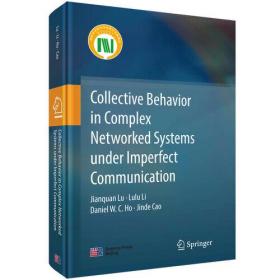
通信约束下复杂网络化系统的群体行为(英文版)
全新正版 极速发货
¥ 103.94 6.5折 ¥ 159 全新
库存2件
作者卢剑权
出版社科学出版社
ISBN9787030693846
出版时间2021-08
装帧平装
开本其他
定价159元
货号1202454376
上书时间2024-11-21
- 最新上架
商品详情
- 品相描述:全新
- 商品描述
-
目录
Contents
Preface
List of Symbols
Chapter 1 Introduction 1
1.1 Background 1
1.2 Research problems 3
1.2.1 Consensus and practical consensus 6
1.2.2 General model description 6
1.3 Mathematical preliminaries 8
1.3.1 Matrices and graphs 8
1.3.2 Signed graphs 9
1.3.3 Quantizer 11
1.3.4 Discontinuous differential equations 12
1.3.5 Some lemmas 13
References 14
Chapter 2 Consensus over Directed Static Networks with Arbitrary Finite Communication Delays 20
2.1 Linear coupling 21
2.1.1 The case of leaderless 21
2.1.2 The case with one well-informed leader 23
2.2 Nonlinear coupling 25
2.3 Hierarchical structure 27
2.4 Numerical examples 28
2.5 Summary 32
References 32
Chapter 3 Practical Consensus of Multi-Agent Networks with Communication Constraints 35
3.1 Practical consensus with quantized data 36
3.1.1 Model description 36
3.1.2 Finite-time practical consensus under quantization 37
3.1.3 Numerical example 41
3.2 Consensus with hybrid communication constraints 42
3.2.1 Model description and preliminaries 42
3.2.2 The existence of the Filippov solution 43
3.2.3 Practical consensus under quantization and time delay 46
3.2.4 Numerical example 59
3.2.5 Discussions 61
3.3 Summary 64
References 65
Chapter 4 Multi-Agent Consensus with Quantization and Communication Delays 67
4.1 Discrete-time case 67
4.1.1 Model description 68
4.1.2 Main results 68
4.1.3 Numerical example 73
4.2 Continuous-time case 74
4.2.1 Model description and preliminaries 74
4.2.2 The existence of the Filippov solution 75
4.2.3 Consensus analysis under quantization and time delays 77
4.2.4 Numerical example 86
4.3 Summary 87
References 87
Chapter 5 Event-Based Network Consensus with Communication Delays 89
5.1 Distributed discrete-time event-triggered consensus with delays 89
5.1.1 Model description 90
5.1.2 Distributed event-triggered approach 91
5.1.3 Numerical example 97
5.2 Distributed continuous-time event-triggered consensus with delays 99
5.2.1 Model description 99
5.2.2 Asynchronously distributed event-triggered approach 100
5.2.3 Synchronously event-triggered control 107
5.2.4 Numerical example 110
5.3 Summary 111
References 112
Chapter 6 Consensus of Networked Multi-Agent Systems with Antagonistic Interactions and Communication Delays 114
6.1 Continuous-time multi-agent consensus 115
6.1.1 Linear coupling 115
6.1.2 Nonlinear coupling 121
6.1.3 Numerical examples 124
6.2 Discrete-time multi-agent consensus 127
6.2.1 Distributed event-based bipartite consensus 127
6.2.2 Self-triggered approach 140
6.2.3 Numerical example 143
6.3 Summary 146
References 146
Chapter 7 Finite-Time and Fixed-Time Bipartite Consensus for Multi-Agent Systems with Antagonistic Interactions 148
7.1 Preliminaries 150
7.2 Finite-time bipartite consensus 151
7.2.1 Finite-time bipartite consensus protocol 151
7.2.2 Pinning bipartite consensus protocol 156
7.2.3 Numerical examples 159
7.3 Fixed-time bipartite consensus 163
7.3.1 General fixed-time bipartite consensus 165
7.3.2 Signed-average fixed-time bipartite consensus 168
7.3.3 Numerical examples 171
7.4 Summary 173
References 174
Chapter 8 Globally Exponential Synchronization and Synchronizability for General Dynamical Networks 178
8.1 Preliminaries 179
8.2 Synchronization analysis 181
8.2.1 Irreducible case 181
8.2.2 Reducible case 189
8.3 Numerical examples 193
8.4 Summary 200
References 200
Chapter 9 Pinning Cluster Synchronization in an Arrayof Coupled Neural Networks under Event-Based Mechanism 203
9.1 Preliminaries and problem formulation 204
9.2 Pinning cluster synchronization under event-triggered mechanism 207
9.3 Pinning cluster synchronization under self-triggered mechanism 214
9.4 Numerical example 217
9.5 Summary 222
References 222
Chapter 10 Multi-Agent Consensus Recovery Approach under Node Failure 225
10.1 Preliminaries 225
10.2 Consensus analysis of general multi-agent networks 227
10.3 Consensus recovery approach 232
10.4 Numerical examples 239
10.5 Summary 244
References 244
Chapter 11 Conclusion and FutureWork 246
11.1 Conclusion 246
11.2 Future work 247
Color Illustrations
内容摘要
对网络群体行为的研究已经成为已成为21世纪网络科学研究的热门问题。在网络化系统中,由于节点间的信息传递,系统整体会呈现出群体行为,比如同步或一致性。需要指出的是,网络的邻居节点之间的信息传输总是不完美的。比如任何通讯网络在单位时间内传输的信息都是有限的并且由于碰撞等因素也会导致数据的丢失,并且信息在传递时,延时等通信也不可避免的存在。另外,网络中的每个节点在信息传输时也会受到在线资源等能量的。所以,对于真实环境中的复杂网络,在信息传输中充分考虑能量、延时、丢包和带宽(量化),寻找网络达到同步与一致性的条件就成为亟需解决的问题。由此出发,本书主要寻求建立一些统一的框架来研究这类问题。本书包括10章,章概述复杂网络和复杂系统动力学模型以及群体行为的定义。第二章和第三章分别探讨带有延时的一般动力学网络的指数同步和一致性问题。第四章和第五章分别针对连续和离散的多智能体网络给出了在一致性研究中处理延时和量化信号的统一方法。第六章、第七章和第十章主要研究了带有能量约束和延时信息的网络一致性问题。第八章和第九章主要研究了带有脉冲信号的耦合网络的同步问题。
相关推荐
-

通信约束下复杂网络化系统的群体行为(英文版)
全新广州
¥ 103.94
-

通信约束下复杂网络化系统的群体行为(英文版)
全新广州
¥ 105.94
-

通信约束下复杂网络化系统的群体行为(英文版)
全新广州
¥ 105.94
-

通信约束下复杂网络化系统的群体行为(英文版)
全新南京
¥ 114.48
-

通信约束下复杂网络化系统的群体行为(英文版)
全新广州
¥ 103.94
-

通信约束下复杂网络化系统的群体行为(英文版)
全新成都
¥ 114.63
-

通信约束下复杂网络化系统的群体行为(英文版)
全新南昌
¥ 113.13
-

通信约束下复杂网络化系统的群体行为(英文版)
全新保定
¥ 116.30
-

通信约束下复杂网络化系统的群体行为(英文版)
全新成都
¥ 114.80
-

通信约束下复杂网络化系统的群体行为(英文版)
全新长沙
¥ 100.12
— 没有更多了 —












以下为对购买帮助不大的评价